Ultimate Guide to Sabiki Rigs and How To Use Them
The Sabiki rig is a cutting edge fishing technique that was first used for baitfish angling in Asia. Sabiki rigs have grown to be known as flasher rigs by a great section of the fishing community. They are the absolute fishing tackle and are now employed all over the world.
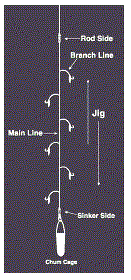
The rig consists of flies with a branch line fastened to the hook. The hook has a flattened end resembling a spade that reflects light and makes the fly even more visible to the fish.
The fly is attached to the mainline by a stiff monofilament that we shall refer to as the branch line. It is stiff so that the branch will hang out away from the mainline to make the assembly appear natural. This also reduces collision among the baitfish, increasing the chances of biting.
It also reduces the chances of tangling up the mainline. If you are patient enough, you even end up with bites on all 6 or 8 hooks.
If you feel like this assembly is too much to keep up with, you will be pleased to know that you are not alone, so did most of us at the beginning. We were overjoyed to learn that most Sabiki rigs come already assembled and are easy to unpack.
How to Use a Sabiki Rig
Due to the make-up of a Sabiki rig, it offers a ton of opportunity and triggers fish to fiercely fight for the food! The features make the Sabiki rig great but it also comes with a different set of skills and you should know how to us it properly before getting started. The main thing to keep in mind when using a Sabiki rig is to not jig or rip too hard or too quickly – in other words, when you feel a bite, don’t jig immediately as you would with a normal hook.
Instead, let more fish fill the other hooks for a few seconds after feeling the first bite. This may be tough because every fishers natural reaction is to rip up instantly as soon as they feel a bite. The harsh ripping motion will cause other fish around the hook to flee and you’ll miss your chance to snag multiple baitfish. Remember: they travel in large groups so if you feel one bite, then you’ll most likely get others a few seconds after.
Fishing with a friend can also be helpful because, as we mentioned above, the Sabiki rig will hook you multiple fish, which means it’s a two-person job to bring those in. Make sure to move carefully and strategically, especially when you’re unhooking your fish. The last thing you want is to injure yourself or the cause unnecessary harm to the fish.
Depending on where you are, adding some extra chum to the hook will help, especially if you’re not getting enough bites. Use small pieces of shrimp or other baitfish – using store bough frozen shrimp and thawing it out works just fine.
This not only increases your changes of hooking a fish, but also increases the size of the fish. Like we mentioned, baitfish travel in large schools and the competition is fierce – if you create an environment that’s more competitive, then you’ll likely get the bigger fish.
What to Look for When Getting a Sabiki Rig
The Sabiki rig provides the best platform for bait fishing and keeping the bait alive as it allows you to catch multiple bait in one cast. You need to maximize the returns by ensuring you get the right one for your specific type of baitfish and the prevailing conditions.
It is designed for light fishing, but since these bait are for larger sport fish, you should be prepared for a few surprises once in a while as you are not the only hunter.
Below are some of the basic items you should consider for your ideal Sabiki rig.
Colors
There are various considerations you should balance between:
- The depth of the targeted structure
- How sunny is the day?
- Distance from the coastal waters
- How cloudy is the water?
- Your target species
As you go deeper, lighter colors lose their visibility while darker colors become more distinguishable. Water absorbs the sharpness of bright colors in what is called the scatter effect.
Fish have an evolutionary advantage with vision underwater and can see better than us the deeper we go. The darker colors become more metallic and vibrant to the fish the lower we drop, so they will just as easily attract your target species.
These variances are why flasher rigs will sometimes use contrasting coloring or paired colors to have an advantage in all scenarios.
If you do shallow water casting, you need not worry about these differences as what you see is not much different from what the fish see.
Hook Size
If the hook is too small, it will not snare the fish after the bite, and if it is too large, the fish won’t be able to bite in the first place.
Depending on the type of fish, expert anglers usually carry two close sizes so that if one is not working, they can switch to the other. This doesn’t take away the importance of determining the right hook size before you set out.
Type of Fish
Thin lines, hooks, and lures may work for small fish like the bluegill or perch but will not hold up against bigger fish. Once in a while, you attract more than the intended baitfish.
Durability
You should examine the composition of the Sabiki rig before you commit. Materials like high carbon steel for the hooks and fluorocarbon filament for the mainline and the branches are sufficient to put your mind at ease. They have both been enhanced to be tough enough for the water and to resist wear and tear.
Strength
Consider the test of both the mainline and the branch against the kind of fish you are targeting and the number of hooks on the Sabiki.
The larger the fish and the more the hooks, the stronger the line needs to be. The tensile strength is often indicated on the package as the test.
Sabiki Rigs You May Want To Sample
The Hayabusa Mix Flasher Sabiki Hot Hooks
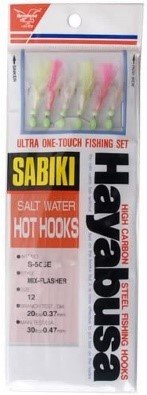
All fish love flies, and these rigs have been made to look like krill, shrimp, and various insects that they thrive on. Some of them even lace their wings with fish oil to add authenticity. Others use synthetic fish skin or natural fish skin for this purpose. The fish skin is sometimes further enhanced by giving it scale-like markings or treating it to a sheen similar to fish. These make that bite irresistible to the baitfish.
Hayabusa is the most renowned and innovative Sabiki manufacturers. Hayabusa Fishing USA has a long history of providing the world with fish hooks since they were founded in 1958. They take pride in being a leading high-grade fishing hook manufacturer representing their Japanese roots. Their mantra is ‘To never give up and do everything possible.’ It is based on Japanese principles of craftsmanship that they faithfully abide by.
They work around the clock to come up with new innovations to improve their already versatile products. It doesn’t come as a surprise then that their Sabiki Rigs collection is celebrated by fishermen worldwide.
These hooks also come in a variety of sizes. For example, you might want to use a size 6 for those days you run into a younger school of fish or a smaller species that are struggling to bite on the size 8.
Angling for bait fish is very sensitive. The longer they stay out of the water, the higher the chance that they will not survive. They are also easily spooked, and the entire school of them might move at the slightest provocation. You want them to move in the right direction toward your wings. This process needs to be fast and efficient.
Whatever type of fish you choose, Hayabusa will come up with the most complete selection of Sabiki lures. Combined their high-quality hooks with the best monofilaments in the industry to come up with innovative, top-quality rigs.
Pros
- Reputable product name
- Made of durable material
- Wide range of options to choose from
- Top-quality rigs
Why the Hayabusa Mix Flasher Sabiki Hot Hook Stands out
This Sabiki rig has been hailed by many experienced bait fishermen to be one of the best gems ever to be dispatched from the Hayabusa kitchen. It enables you to catch live minnows as it ensures you have ample opportunity to keep them alive for their intended purpose. There are various reasons for this consensus.
Reputation of the Manufacturer
Hayabusa is one of the most lauded brand names in terms of fishhook making. They have perfected the art over many years of innovation and the quest to stay relevant to current needs. Their products are working, and they have earned their loyalty.
Durability
Modern technology has been employed in ancient knowledge to produce some of the finest hooks that are easy to use but are tough against extreme conditions. Carbonated steel can withstand any punishment the water will throw at it, so the hooks will hold. The monofilament line used as the mainline and branches is fluorocarbon-based, making it not only tough but strong enough to carry the weight of the fish over and over without letting up.
Opportunities for Variation
You can catch fish without bait on the hooks, but it is more effective to put decent baits on them. The shiny metal pieces that are constant in most Sabiki rigs are sufficient to trigger a bite from a baitfish.
They go a step further and introduce enhancements for these lures in various forms such as flashy colored flies, wings laced with fish oil, synthetic fish skin, and even actual fish skin.
This makes the baitfish go wild, but Hayabusa had already anticipated this, and the rigs have different variations of multiple hooks to reel in as many as you possibly can. This is the ultimate baitfish machine.
Categories: Fishing
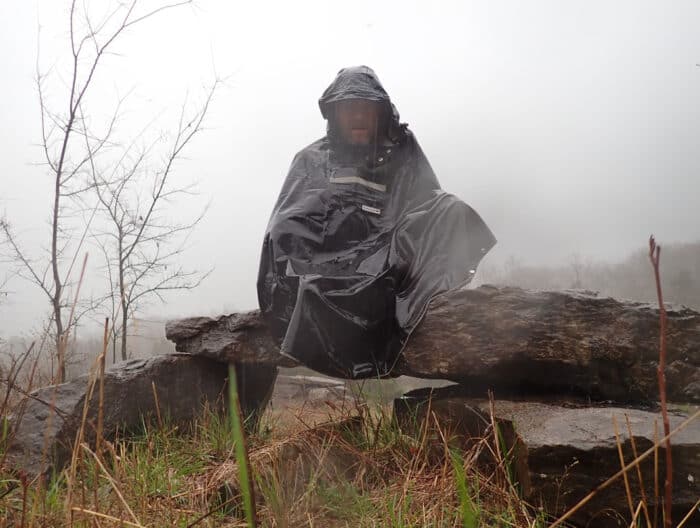
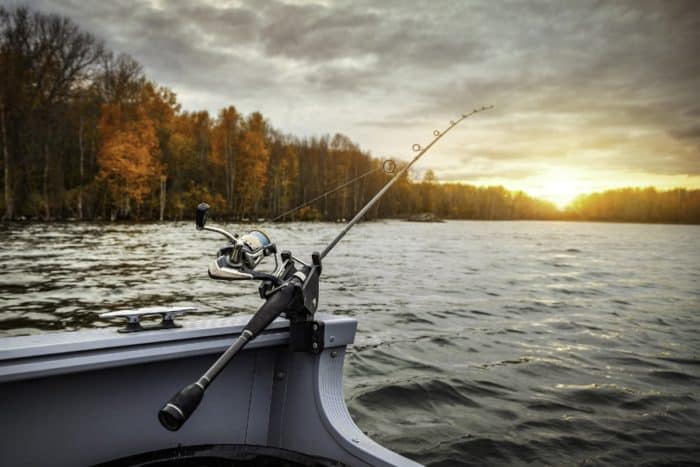

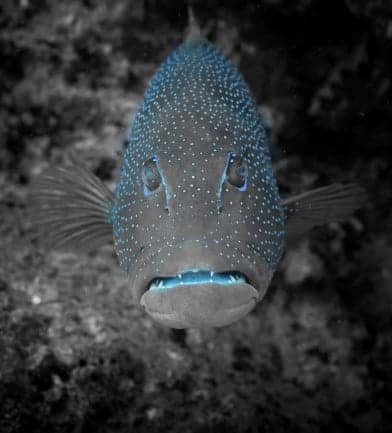








1 Comment
Kathy Johnson on February 15, 2023
Where can I find all the things to make my own Sabiki rig? Do they work on lakes?